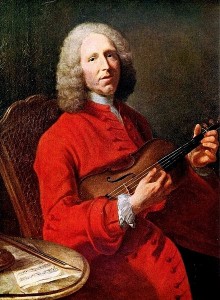Rameau, Les Sauvages
In 1725, Chief Chicagou of the Mitchigamea tribe in Illinois visited Paris and met with King Louis XV. The Company of the Indies, which controlled business with the French colonies in America, arranged the visit for Chicagou and five other chiefs. During the visit, the chiefs performed three dances representing peace, war, and victory—a performance attended by Jean-Philippe Rameau.
 Rameau was inspired by the performance to write this short rondeau. The Air des Sauvages was included in Rameau’s Nouvelles Suites de pièces de clavecin (1728). It then was recycled as an overture to Act IV of his opera Les Indes galantes.
Rameau was inspired by the performance to write this short rondeau. The Air des Sauvages was included in Rameau’s Nouvelles Suites de pièces de clavecin (1728). It then was recycled as an overture to Act IV of his opera Les Indes galantes.
But how does a French Baroque composer represent Native American music to French audiences? Certainly he needed some exotic sounds and had no knowledge of authentic Native American music. We can be sure there were no ethnomusicologists in Illinois reporting back to Paris at the time.
First, remember that French music celebrated dance and grand processions. You certainly hear the dance influence in this piece. The dance is not a refined minuet or sarabande, but has a lively and somewhat angular and primitive character. And it has many of the stylistic features of what Europeans called “Turkish” music: angular melodies, square rhythms with strong downbeats, and heavy use of percussion, particularly triangles and bells. In fact, the opera Les Indes galantes celebrates the exotic with action set in Persia, Peru, North America, and an island in the Indian Ocean. Exoticism, not ethnographic authenticity, brought in audiences. This was the exotic sound of the day, whether it was intended to represent Persia or Illinois.
This performance features a Turkish Crescent containing bells mounted on a pole. It later became popular with European bands (a result of the popularity of the “Turkish” sound) and was known in British bands as a Jingling Johnny and, in Germany, a Schellenbaum.
Now compare the earlier Pièces de clavecin (harpsichord):



